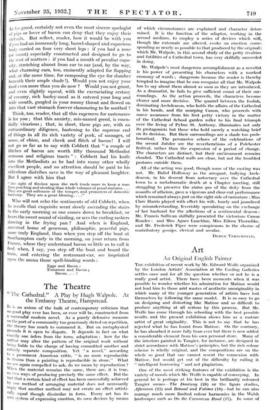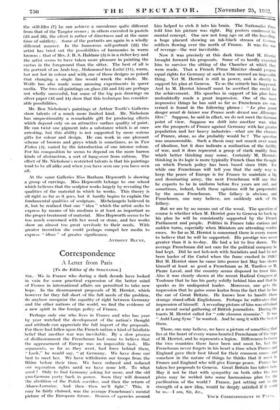Art
An Original English Painter
TILE exhibition of recent work by Mr. Edward Wolfe organized by the London Artists' Association at the Cooling Galleries settles once and for all the question whether or not he is a really good artist. There have been moments when it was possible to wonder whether his admiration for Matisse would not lead him to those arid wastes of aesthetic unoriginality in which many of the younger generation of artists have lost themselves by following the same model. It is so easy to go on designing and distorting like Matisse and so difficult to produce anything at all serious by this process. But Mr. Wolfe has come through his schooling with the best possible results and the present exhibition shows him as a mature artist of great originality. This is not to say that he has rejected what he has learnt from Matisse. On the contrary, he has absorbed it more fully than ever but there is now added a considerable element from his own personal store. Many of the interiors painted in Tangier, for instance, are designed in strict accordance with Matisse's principles, but the rich colour scheme is wholly original, and the compositions are on the whole so good that one cannot resent the connexion with Matisse, but would get out of the difficulty by calling it "intelligent borrowing" and not plagiarism.
One of the most striking features of the exhibition is the variety of moods which Mr. Wolfe is capable of conveying. In general he is perhaps at his best in the brilliantly coloured Tangier scenes—The Doorway (28) or the figure studies, Afternoon (25) and Bdsotd and Fatima (18)—but he can also manage much more limited colour harmonies in the Welsh landscapes such as On the Carnarvon Road (17). In some of
the still-lifes (7) he can achieve a succulence quite different from that of the Tangier scenes ; in others executed in pastels (23 and 26), the effect is rather of directness and at the same time of subtlety-. Some of the portraits are again in a wholly different manner. In the humorous self-portrait (22) the artist has tried out the possibilities of harmonies in warm browns ; that of Mrs. J. B. S. Haldane (5) is in a richer key and the artist seems to have taken more pleasure in painting the cactus in the foreground than the sitter. The best of all is the portrait of an Arab boy, Mohammed ben Lailsi (11), warm, but not hot in colour and with, one of those designs so poised that changing a single line would wreck the whole. Mr. Wolfe has also made some amusing experiments in queer media. The two oil-paintings on glass (33 and 34) are perhaps not wholly successful, but some of the big pen drawings on silver paper (43 and 44) show that this technique has consider- able possibilities.
Mr. Ben Nicholson's paintings at Arthur Tooth's Galleries show talents of a much more limited kind. Mr. Nicholson has unquestionably a remarkable gift for producing effects which depend only on an attractive surface quality of paint. He can twist one pigment into a substance which is at once arresting, but this ability is not supported by more serious gifts for colour and design. He can work in one pleasant scheme of browns and greys which is sometimes, as in Two Fishes (4), varied by the introduction of one intense colour. For his composition he seems to depend on the more barren kinds of abstraction, a sort of hang-over from cubism. The effect of Mr. Nicholson's restricted talents is that his paintings tend to be all alike and when you have seen one you have seen all.
At the same Galleries Miss Barbara Hepworth is showing a group of carvings. Miss Hepworth belongs to one school which believes that the sculptor works largely by revealing the qualities of the material in which he works. This theory is all right as far as it goes, but it hardly begins to explain the fundamental qualities of sculpture. Michelangelo believed in it, but he realized that one "idea" which the artist seeks to express by means of his medium is at least as important as the proper treatment of material. Miss Hepworth seems to be too much concerned with her wood or stone, and her works show an almost too great servitude to their needs. With greater invention she could perhaps compel her media to express ideas of greater significance.
ANTHONY BLUNT.







































 Previous page
Previous page